Beginning in the 15th century in a land known today as Vietnam, Dai Viet – an empire of the Viet people from the north – which had successfully defeated their long-time rival, the Chams, expanded their territory further south. Quite the opposite of the Hindu-influenced Cham culture, that of the Viet people who originated from what is now southern China and northern Vietnam was heavily influenced by Chinese beliefs and traditions. Like many other conquerors across the globe, the Viet introduced their culture, albeit forcefully, to their newly-conquered land. Since gaining independence from China in the 10th century, Dai Viet had grown into a significant power in the region with successive dynasties ruling Imperial Vietnam.
Similar to Imperial China which saw the rise and fall of powerful dynasties and warlords over thousands of years, Vietnam entered its own feudal period in the 16th century when its lands were controlled by rivaling warlords and clans. It was only in the early 19th century when Vietnam was once again unified, this time under the rule of the Nguyen dynasty with Emperor Gia Long, born Nguyen Anh, as its very first monarch. To mark the rise of a new Imperial Vietnam, the emperor commissioned geomancers to look for an auspicious site to build a new palace. Situated on the western banks of the Perfume River in central Vietnam, Hue was chosen as the location for the new seat of power.
It is said that during autumn in the past, flowers from the orchards along the river would fall into it and make the river fragrant, hence the name. And it was apparent that according to geomancy, this part of Vietnam had everything a palace needed, including Hue’s Ngu Binh Mountain which provided a protective screen to shield the palace from malevolent spirits. In 1804 construction of the citadel began. Guarded by protective walls and moats, the citadel would later host the Imperial Residence, the Imperial City, the Forbidden Purple City and many other structures.
The entire palace complex served as the seat of the Nguyen dynasty for almost one and a half centuries, a period of time remembered for the increasing influence and control of France over Vietnam. In 1945, following the defeat of Japan in World War II and the successful revolt of Viet Minh – Vietnam’s coalition for independence – the French briefly returned to Vietnam and waged war against the Chinese-backed Viet Minh for almost a decade. In 1954, an agreement was reached between Viet Minh and the French government, allowing the former to control the northern part of Vietnam while maintaining the Nguyen dynasty’s nominal control over the south. However, the king, who was backed by the French, was deposed a year later by his own prime minister who then became the first president of South Vietnam, marking the demise of Imperial Vietnam. Hue, precariously located near the demilitarized border between the north and the south, was no longer the capital as the seat of the new Western-backed republic was centered in Saigon, far to the south.
On January 31, 1968, when the Vietnamese were celebrating Tet – the Vietnamese New Year – the North Vietnamese and Vietcong forces launched a surprise attack on Hue, an important base for the U.S. Navy supply boats. The citadel, at that time used as the headquarters of the 1st Infantry Division of the South Vietnamese Army, was an apparent target. Almost six hours after the first attack, the North Vietnamese troops successfully took control of the citadel and raised a Vietcong flag over its flag tower. The North and South Vietnamese troops were involved in a fierce battle concentrated around the historic complex, and finally more than three weeks after the first assault was launched, the U.S.-backed South Vietnamese Army regained control of the citadel. The U.S. and South Vietnam did emerge victorious, but roughly 80% of Hue was destroyed by U.S. airstrikes, a fact that raised questions among ordinary Americans and contributed to the decline of U.S. public support for the war.
Photos of the destruction of structures within the citadel emerged – a kind of image which unfortunately keeps surfacing even to this day with multiple wars and conflicts on the planet. 25 years after the end of the Siege of Hue, the Imperial City joined the prestigious UNESCO World Heritage list, a testament to its past significance despite the sheer damage to the compound decades earlier. Then almost 25 years later, I get the chance to visit this marvelous work of Vietnamese architecture and craftsmanship and retrace its glorious, as well as dark, days.
Walking through the magnificent Meridian Gate – modeled after the one in Beijing’s Forbidden City – it is not hard to imagine the power the emperors held during the heyday of the Nguyen dynasty. Miraculously kept intact during the war, the gate still impresses modern-day visitors, as it must have done with royals and dignitaries alike in the past. Past the gate is Điện Thái Hòa, the Palace of Supreme Harmony, built by the first Nguyen emperor in 1805, then enlarged and moved to its current location by his successor in 1833. James and I then turn to our left side to an enclosed part of the Imperial City. Inside, the ancestral temples of Thế Miếu and Hưng Miếu stand in a tranquil setting with their doors open.
Exploring the many corners within the vast palace complex is like looking into Vietnam’s past. The lavishly embellished halls, temples and gates attest to Imperial Vietnam’s prominence and wealth. On the other hand, the ruins and unrestored parts inside the compound are a grim reminder of yet another man-made calamity the world has been witnessing for millennia. The heart of the palace grounds, usually reserved for an important structure, is conspicuously empty. Indeed, a grand hall once stood here, none other than the emperors’ office itself. It is here, under the scorching heat of Vietnamese sun, where we call an end to our visit to the impressive Imperial City of Hue. Under the same sun the citadel had seen emperors commissioning structures to impress, belligerents vying for control of this strategic asset, modern researchers meticulously studying what remains of the citadel for future restoration works, and visitors marveling at the results of the ongoing project. The allure of the Imperial City, it seems, endures to this day.







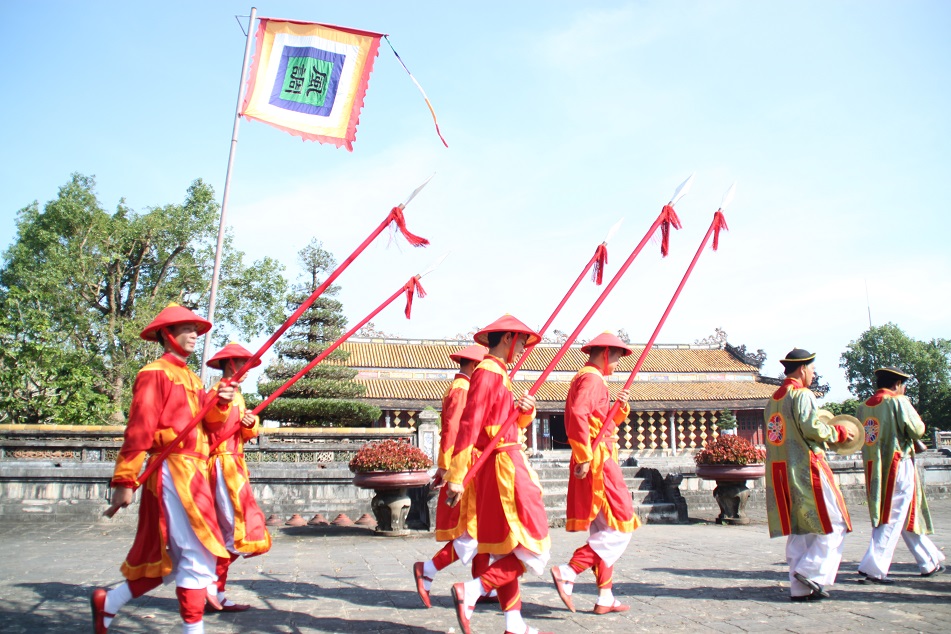

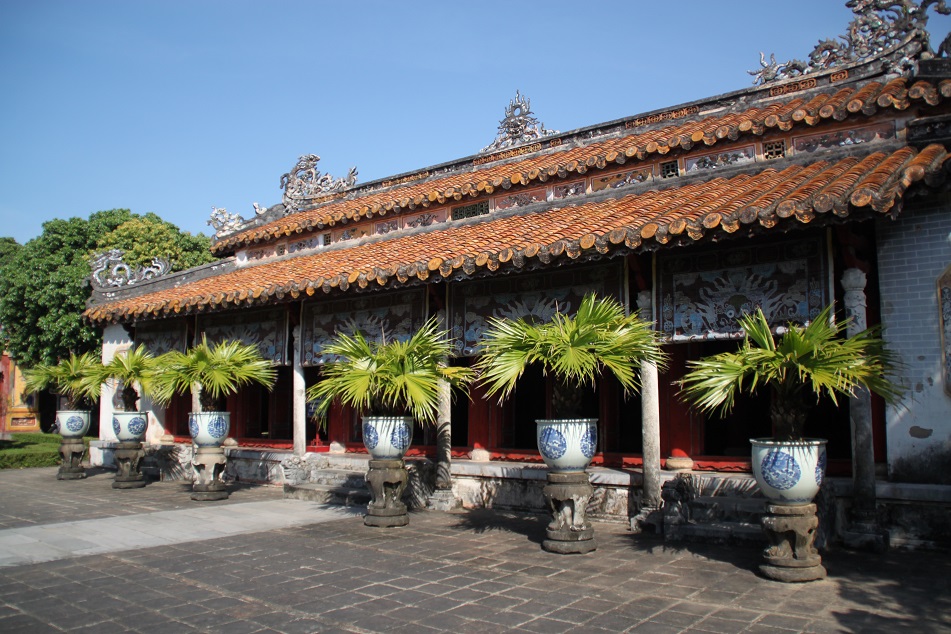




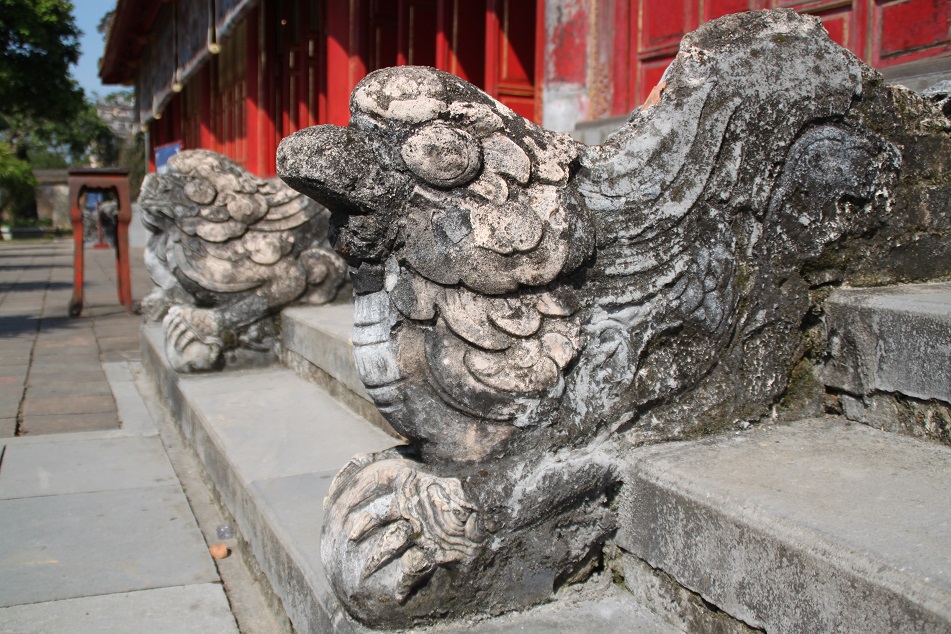


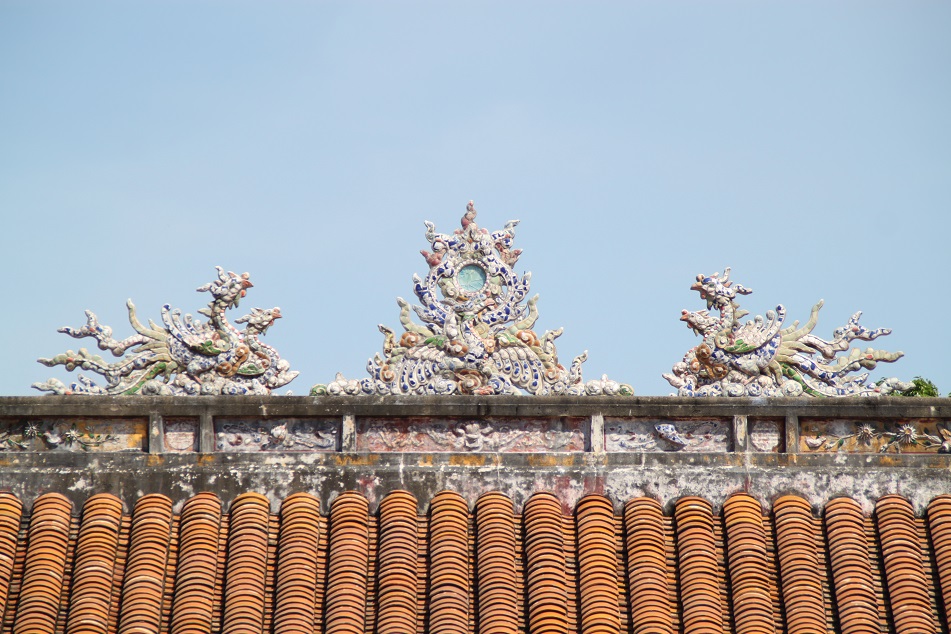
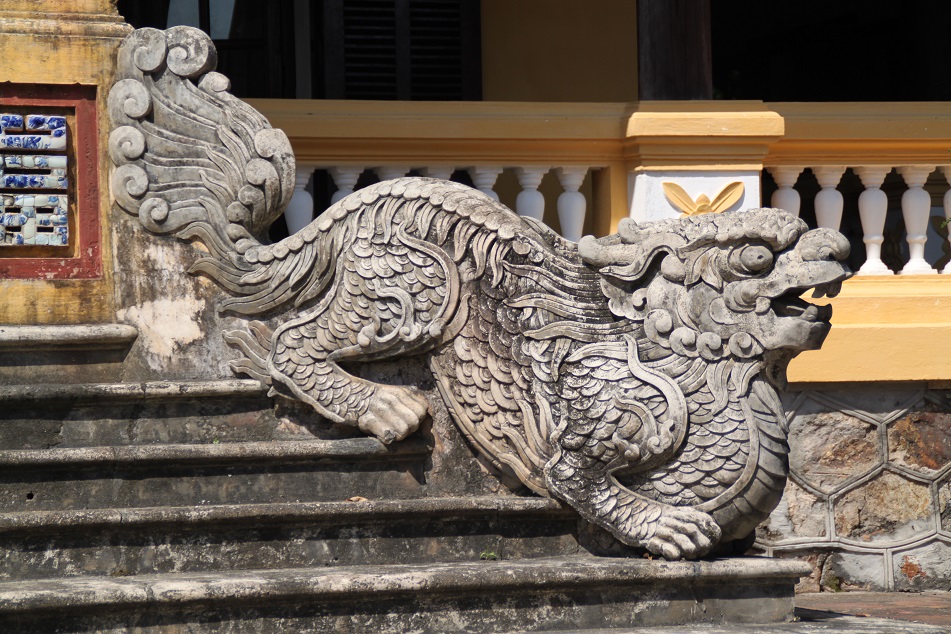
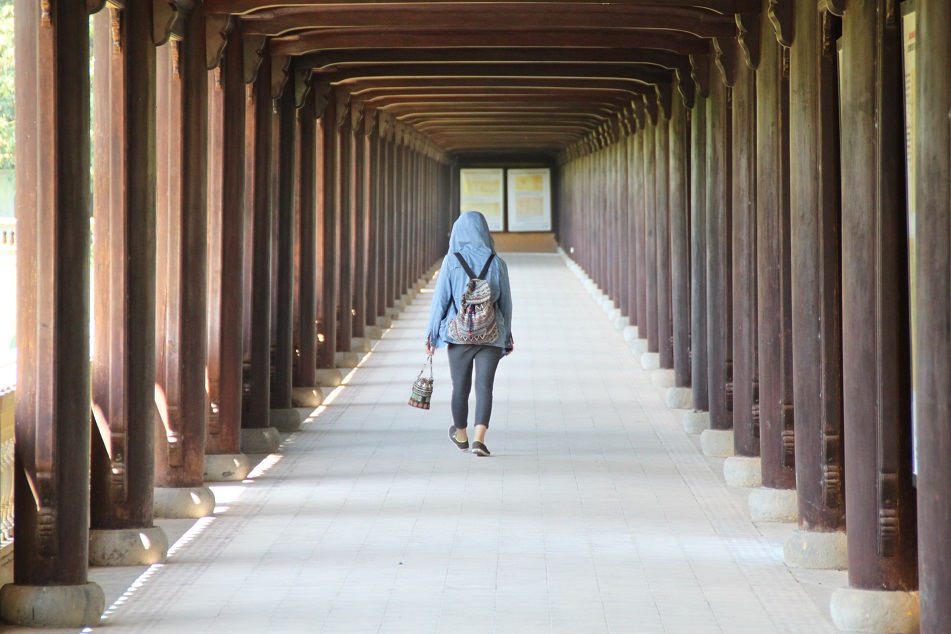
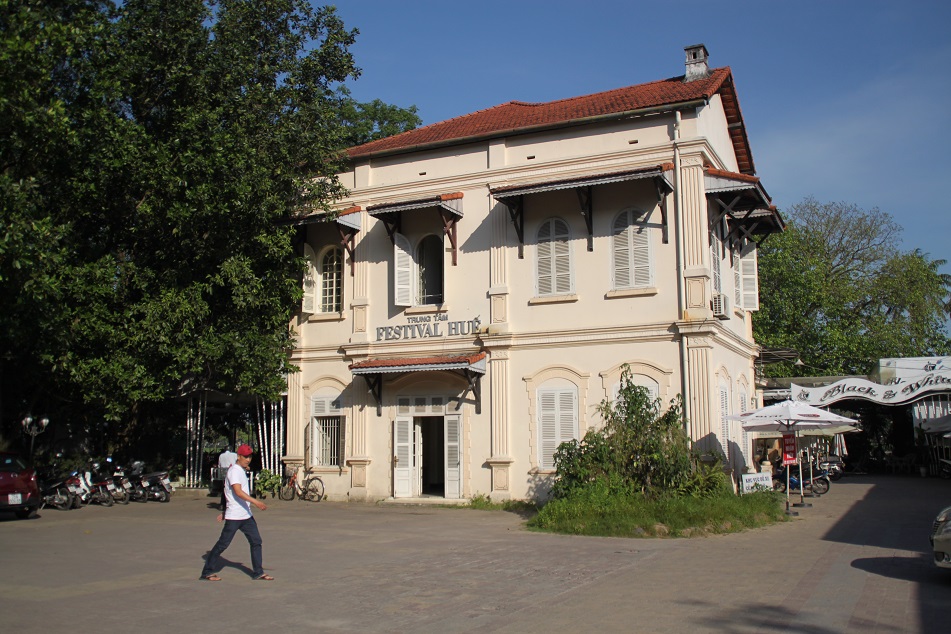


Great post, and then you end it with a photo of a mouthwatering soup! Between your post and James’ post today, I’m missing Asian food more than ever, ha ha! 🙂 Thanks, Bama! Hope you’re enjoying the weekend.
LikeLike
Thanks Kelly! Maybe that’s a sign for you to plan another trip to Asia? Just to eat. 😉 I had bubur ayam (Indonesian style chicken congee served with fried soy beans, chopped scallion, crackers, and chili sauce) for breakfast today, something I think you should try when you come to Jakarta one day. Have a relaxing weekend too!
LikeLike
Bubur Ayam?! Never even heard of it, but it sounds delicious. You had me at chili sauce. 🙂 Thanks for the tip!
LikeLike
You’re very welcome, Kelly. 🙂
LikeLike
Such beautiful photos and descriptions. I like the details in the sculptures. Would love to see this fascinating place of history.
LikeLike
Much appreciated, Stewie. Bear in mind that this part of Vietnam can be really hot! And this is coming from a person who has been living in a hot and humid tropical city called Jakarta. But the inconvenience will be paid off as Hue Citadel as well as the royal tombs around the city are truly impressive!
LikeLike
I just googled it, and the temperature gets to 35-40 degrees. That’s hot, yes. Yikes. Those poor people dressed in costume.
LikeLike
When I went in April, it was more than 40 degrees at midday. The trick is visiting the palace and the tombs really early in the morning or in the afternoon, and go somewhere with aircon at lunch time. 🙂 I had the same thought when I was taking photos of those people.
LikeLike
I’ve heard so much about Vietnam. So many people I know were there, but nobody brought pictures. Isn’t that strange. Thank you for the beautiful photographs! I bet that soup is hot!
LikeLike
I wonder why no one brought pictures of the country to you. I’ve only been to Saigon (and some places around it) to the south as well as several places in Central Vietnam. It really is an intriguing country for its long history, magnificent heritage sites, and delectable food! Speaking of the soup, it was supposed to be hot. But my Indonesian palate is used to handling even more fiery dishes. 🙂 Thanks for reading!
LikeLike
Very impressive post on the history and culture of Vietnam! This is a country not very well known in the West except perhaps by the horrors of the war. As always I admire your photos, which go together well with your report.
LikeLike
Vietnam is fascinating in many ways thanks to its history (the Chinese-influenced Viet and the Hindu-influenced Chams left a plethora of impressive heritage sites across the country), its food (fresh, healthy and tasty), and its landscape. Thanks for reading and for sharing your thoughts, Peter. We all surely hope that the world can learn from the Vietnam War that we should never take peace for granted.
LikeLiked by 1 person
Great historical article and tantalizing bun bo hue picture. Love this!
LikeLike
Glad you enjoyed this post, Kat! We had the dish more than once throughout our stay in Hue. Despite the heat of humidity of the city, Bun Bo Hue was in fact very refreshing.
LikeLike
Great post about one of the best places in Vietnam. Hue has so much going for it – glad you enjoyed it as much as we did!
LikeLike
My friend and I enjoyed Hue so much, except for the heat. But the magnificent palace, impressive tombs, and delicious Vietnamese dishes really made up for all the sweat! Thanks for reading, John.
LikeLiked by 1 person
this was an outstanding
LikeLike
Hi Ranjan. Thanks for dropping by. I’m really glad you enjoyed this post!
LikeLike
Beautiful inspiring post, Bama!
Maybe it’s time for me to visit Vietnam soon: )
Some scenes of the beautiful period movie ‘Indochine’ were shot in the citadel. Check it out!
LikeLike
Thanks Suwandi! Well, you know Indonesians don’t need a visa to visit Vietnam, and there are several flight options to reach Saigon. 🙂 I’ve heard of the movie but I haven’t watched it. Thanks for suggesting that!
LikeLike
Love it! You have nicely summarised hundreds year of Vietnamese history in just a few paragraphs. The photos are awesome as always, especially the Bún Bò Huế 😉 Do you like it? I visited Hue about 5-6 years ago, but it was too hot so we could not see all the places in the city. I think I missed the Thế Miếu Temple.
LikeLike
Honestly, it’s rather impossible to summarize the history of Vietnam just in one blog post. But I tried to at least present the bigger picture. I loved Bún Bò Huế, so much so my friend and I decided to try several places to find the best. Even a Vietnamese says Hue is way too hot! 🙂 Probably it was the hottest place I’ve ever been to so far. That’s why we made sure to always go in the morning or late afternoon. Thanks Len!
LikeLike
Great post! Well done!
LikeLike
Always appreciate your kind words, John and Susan!
LikeLike
I’ve just known that Hue was a former capital. The citadel is sooo Chinese! Looking the pictures without reading your story would make me think that those are somewhere in China.
LikeLike
Indeed, the imperial palace complex in Hue was inspired by the one in Beijing. Even with many of its original structures still in ruins, Hue Citadel was very impressive and beautiful. Now I’m really curious to see the Forbidden City in the Chinese capital.
LikeLike
Oh, you haven’t set your foot in Beijing. I thought you had. Looking forward to your stories in Beijing then 🙂
LikeLike
Hopefully one day. 🙂
LikeLiked by 1 person
At the time when we were living in Hoi An, Viet Nam we motorbiked from there, over the mountain range to Hue. It was quite an adventure, which took us about five hours because we stopped so much along the way at a gorgeous river and as well to eat yummy food that came our way. Speaking of food we remember that at the CItadel we saw photographs and descriptions of how the emperor would have 50 cooks make 50 dishes for every meal. Thanks for the memories and added information on the extensive and interesting history.
Peta
LikeLike
I remember the Hai Van Pass being particularly awe-inspiring and beautiful with its sweeping vista of the sea and the verdant mountains. It’s amazing that you went all the way from Hoi An to Hue by bike! Such a luxury it must have been to be able to stop whenever you wanted to take photos and marvel at the beauty. Speaking of the food, isn’t Vietnamese food amazing?! Even the dishes for ordinary citizens are already so scrumptious, let alone those served for the emperor. You’re welcome, Peta. And thanks for reading and sharing your story!
LikeLike
Reblogged this on Carlton D Kennedy and commented:
Amazing read, would lie to visit one day.
LikeLike
Thanks for the reblog, Carlton. I hope you’ll get the chance to visit Hue sooner than later!
LikeLike
Absolutely amazing!
LikeLike
It really is! Hopefully we’ll see the day when the entire citadel is completely restored to its former glory.
LikeLike
What an impressive history, and to be able to walk around this citadel and soak in all of the past must have been something else Bama ~ incredible photographs to go along with the amazing read. And then the perfect way to end it all, with a bowl of Bún Bò. Not only would I like to walk these grounds, but also taste Hue’s Signature Beef and Vermicelli Soup 🙂
LikeLike
When you do come to Hue and visit the Imperial Citadel, make sure to bring a lot of water. The scorching sun can be a little unbearable to say the least. But heat and humidity aside, this former palace compound certainly was very impressive. When I was there some parts of the citadel were in fact being restored. Very encouraging, indeed. Traditionally the locals eat the soup for breakfast, but you can also have it for lunch and dinner at a number of restaurants in the city. Thanks for reading and sharing your thoughts, Randall!
LikeLiked by 1 person
Some stunning captures, Bama! As much as I enjoyed the food and atmosphere in Hoi An, I think Hue was my favorite place in central Vietnam. I’d previously read that Hue has notoriously bad weather (with a lot of rain) so I was pleasantly surprised to see such blue skies over those several days we were there. I do remember the heat and humidity though! Even walking down the street at a normal pace was enough to work up a big sweat. I’m so glad we visited the Imperial Citadel first thing in the morning… though a lot of it was destroyed in the Tet Offensive, the halls that survived remain an impressive sight. And it was great to see a multi-story pavilion being reconstructed using the original techniques.
LikeLike
Makasih James! Luckily the aircon in our hotel worked just fine, so we could seek refuge from the midday heat. Heat and humidity aside, I also enjoyed Hue very much, and it makes me wonder if our experience in Mandalay would have been different if the weather was nicer. Actually the citadel exceeded my expectation, and I’m glad we explored the Purple Forbidden City first as we had this part of the palace ground mostly to ourselves. Destroying such heritage site always takes much shorter time than building it. But the reconstruction work that we saw really was a very encouraging sight.
LikeLike
👍
LikeLike
Thanks for dropping by, Bushra. Glad you enjoyed this post.
LikeLiked by 1 person
Very interesting. I’ve always considered visiting Vietnam. thank you for this read
LikeLike
Vietnam is fascinating for many reasons: long history, beautiful architecture, majestic landscape, and delectable food among other things. Hope you’ll get the chance to go there, Loring. Thanks for reading!
LikeLike
Well research, Bama! Judging by the pictures alone, one would assume they were taken in China. Thank you for the history of Dai Viet!
LikeLike
Thanks Indah. After visiting the Imperial Citadel in Hue, I’m really intrigued by Beijing’s Forbidden City. It must be even more magnificent!
LikeLike
Actually Beijing’s Forbidden City’s general project manager was a Vietnamese people, Nguyễn An, who was arrested in the Minh invasion to be an eunuch in Minh palace. He was found talented by the King and soon be pointed to this important post of the project. This has never been noticed in the history of Beijing Forbidden City.
LikeLike
I’ve never heard about this either until you mentioned it. Sounds like there are already quite a lot of things to learn before I even set my foot in Beijing. Thanks for reading and sharing this intriguing story!
LikeLiked by 1 person
Love every single frame in this post Bama. And the accompanying historical background. Amazed by how much is still standing after the ravages of extended war in the region. Glad to read that it is being restored/reconstructed with sensitivity.
LikeLike
Thanks Madhu! I guess the Imperial Citadel to the Vietnamese is comparable to the Forbidden City to the Chinese. They are reminders of both countries’ imperial period, which paradoxically is contradictory to the Communist system they officially adopt today. However, it is very encouraging to see the ongoing restoration work at the citadel.
LikeLiked by 1 person
Pingback: Hue Tombs: Opulence for Eternity | What an Amazing World!
I travel vicariously at every opportunity and your posts are superb! Glad I stumbled onto your blog!
LikeLike
Hi Tammi. Glad you enjoyed some of the posts in this blog! Traveling vicariously is the first step to traveling the world ourselves, isn’t it?
LikeLike
Such a wonderful place, and it comes alive to me through your photos and description. Clearly I have to go back to Vietnam, since I barely saw anything on my first trip. I remember a soup very like Bun Bo, though.
LikeLike
Vietnam is definitely one of those places where I can see myself returning in the future. Hopefully you’ll have more time to explore the country next time!
LikeLiked by 1 person
Pingback: Da Nang and the Friendly Dragon | What an Amazing World!